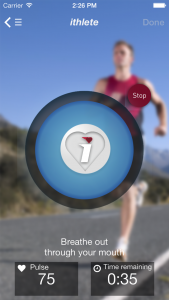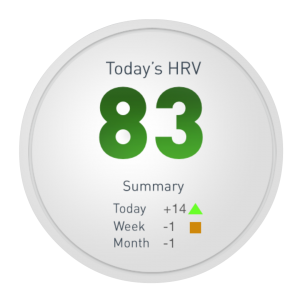Performing the Daily Measurement with ithlete
Here are recommendations for taking your daily heart-rate variability (HRV) measurement:
Take the 60-second test in the morning, before breakfast or caffeinated drinks.
The exact time is not as important as making sure you are relaxed. Some people find that the best time is straight after getting out of bed, others prefer to walk around, or do a little light stretching first.
After waking up, put on your chest strap (moisten the contacts), or ithlete finger sensor. Relax and concentrate on the animation of the circle on the screen. Press Start to begin once the button turns green, indicating that your heart rate is stable.
Breathe deeply and relax
 To stimulate your nervous system in a consistent way ithlete is based on paced breathing. It is important to follow the expanding blue circle as you breathe in and out. We suggest breathing in through the nose, and out through pursed lips, but find whatever works best for you. It’s not important if you don’t expel all the air from your lungs, so don’t force it!
To stimulate your nervous system in a consistent way ithlete is based on paced breathing. It is important to follow the expanding blue circle as you breathe in and out. We suggest breathing in through the nose, and out through pursed lips, but find whatever works best for you. It’s not important if you don’t expel all the air from your lungs, so don’t force it!
Your first week.
It usually takes a week to 10 days to get used to the measurement, breathing pattern and for your baseline to be established. Trust the first reading, unless you have some real reason to doubt its accuracy, in which case wait a few mins & repeat. Heart rate variability is a sensitive measure for sure, and anxiety about a real or possible low reading can affect the reading itself.
Stay consistent.
You can’t compare readings made at different times of day – our bodies have daily (circadian) rhythms that naturally lead to fluctuations. Caffeine, alcohol and physical activity all have substantial effects on your reading. First thing in the morning is the best time. There will be some days when you get up especially early or late, compared to your normal routine. Readings on these days may be lower or higher than expected, and should be judged in the light of this.
Body position.
You can’t compare readings made in different positions i.e. lying / sitting /standing. The standing position is best for athletes, since athletes tend to have low resting heart rates (anything below 60 beats per minute). Researchers have found that if your resting heart-rate is very low lying down then the gap between heart beats reaches a maximum value and the HRV variability does not increase further. This is not a problem medically, but it limits the range of measurement and you might miss some changes & further improvements in your daily value. When you stand up, your nervous system adjusts your heart rate upwards about 10 bpm (depends on your height, build etc), and you see the full range of HRV when you breathe. Researchers also found a better ability to detect overtraining from HRV in the standing position.
So, whilst we recommend doing the ithlete measurement standing up, if your usual resting heart-rate is in the mid 50s or higher and you are more comfortable doing the test sitting, then that should be OK. Some recent research studies have done morning HRV tests on moderately fit recreational athletes lying down (supine) and had good results.
Interpreting HRV measurements
Daily Change indicator.
This is the key indicator that helps you assess how well recovered you are from previous training and other stress sources.
The number in the center of the indicator compares today’s reading with yesterday’s, and the color-coding shows whether or not today’s reading has changed significantly compared to your baseline.
This indicator will turn:
- Amber if your HRV reading is significantly low compared to baseline
- Train lightly (reduced intensity and volume)
- Red if both your HRV is significantly below baseline and your resting HR is also out of the usual range
- Rest required
- Green to show your HRV and resting HR are in the normal range and recovered sufficiently
- Train normally according to your training plan
If the indicator is amber, you can either train lightly, keeping the intensity low, or take a rest day. Light intensity (fully aerobic) training is much less stressful than anaerobic training, and may assist with speeding up recovery. A red indication on the other hand, really means rest!
There is one other situation where you can get a red daily change indicator, and that is if your resting heart rate has suddenly lowered significantly, often accompanied by an unusually high HRV reading. This could indicate the onset of parasympathetic overreaching, where your body is really exhausted. It’s a condition that is difficult to diagnose reliably, and hard to cure, so if you see a red daily change, together with an unusually low heart-rate always ask yourself honestly if there’s a reason or if you have been overdoing it. If in doubt, repeat the test after doing some gentle warms ups, household tasks, or light stretching.
Weekly Change.
The number in the middle of this indicator shows the change in the average of your daily readings over the last 7 days. It is used to gain an indication of the short-term trend in your stress / recovery state.
During a period of intensive training preparing for or participating in competition, this indicator may go amber, showing that your nervous system is becoming more sympathetic (fight or flight) dominant. This is not necessarily bad in the short term, and it may be that you achieve good performances in this ‘peaked’ state, but if the indicator turns red, you may well need a couple of days extra rest or active recovery to avoid early stage overtraining.
Conversely, a green Weekly Change indication can follow intensive weeks, and is a good sign during tapering or during the easy week of monthly periodisation. A green shows that your body is responding well to the change of emphasis away from high intensity.
Monthly Change.
Just as for the Weekly Change indicator, this shows the change in average HRV over the past month, and therefore the trend. A positive number, often accompanied by a green indicates improving aerobic fitness during the endurance base building phase, or it could indicate lifestyle improvements, such as more / better quality sleep, or a healthier diet. It is quite usual to see the Weekly and Monthly indicators turn green during holidays – this shows that rest and change of environment were definitely needed!
A negative number accompanied by an amber may follow a transition from off season or base building to the higher intensities pre-competition, or may indicate temporary overreaching, but red is a sign that overtraining trouble could be on the way.

Hello Simon,
Very didactic. On your word, I changed my protocol from lying down to standing up. But the thing is …I’m not an athlete. By far !
In fact I might be one of the rare person using Ithlete to try to recover from Chronic Fatigue Syndrome. I pre-suppose that methods for athlete training should have a lot in common with CFS recovery therapy.
When I read I’m seriously thinking about going back to supine measurement. ( Best for fatigued people ;-) )
When I read : – tests on moderately fit recreational athletes lying down…/…had good results – I conclude that since my case could be likened to “VERY recreational”
I should have VERY good results too…
In fact I have been more than happy with that way of using Ithlete for nearly 2 years. Plus I could more easily compare today’s HRV with precedent values
Hi Yves-Marie,
I wish we could be more clear about this. I have some ideas but they are not ready to be made public just yet. In the meantime, the research evidence on parasympathetic saturation suggests that for people with a resting HR < 55 bpm (normally considered athletes :-) they are more likely to get good results with their body in an upright position, ie sitting or standing (for people with a very low RHR). Let's also remember that the majority of all research conducted on HRV has been done using ECG in the supine position!
.-)
Hi Yves- Marie, I too have suffered from CFS. I am also an athlete! I have experienced severe bouts of over training during the last 5 years. One thing I have noticed is that ithlete is much more sensitive in the standing position. My base RHR used to be in the low 40,s it is presently about 54 when sat and relaxed. Most ithlete measurements whilst standing are in the 68-74 region. My observation is that the DAILY change in HRV increase dramatically when I am approaching overtraining. If I allow a good week for recovery it is +/- 5, whereas it can peak +/- 25 when I overdo it. This may well be a good indicator for you as to how well you are adpating to the training – whether you are trying to do too much or not. I would be interested in Simon’s thoughts…